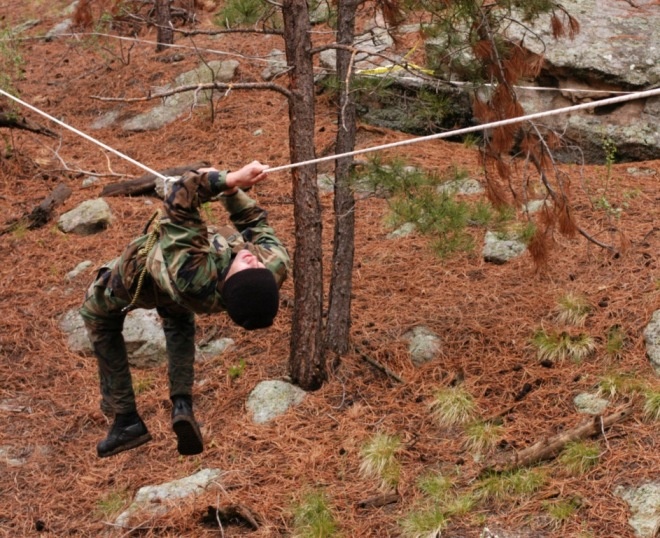Part B
Consider the same rope bridge. If the person is at rest exactly 1/6 of the way along the bridge (as measured horizontally) what is the tension in each side of the rope in terms of the person's weight? Assume that the length of the rope is constant.
Solution
System, Interactions and Model: As in Part A.
 Approach: Approach:
 Diagrammatic Representation Diagrammatic Representation
The new picture is:

which gives the free-body diagram:

Note that now we do not have symmetry about the location of the person and so both the angles and the tensions can be different on the two sides. |
 Mathematical Repesentation Mathematical Repesentation
The equations of Newton's Law give:
\begin{large}\[ T_{1}\cos\theta_{1} - T_{2}\cos\theta_{2} = 0 \]
\[ T_{1}\sin\theta_{1} + T_{2}\sin\theta_{2} - mg = 0\]\end{large} |
These equations cannot be solved without further information. The extra information is the length of the rope. We know from Part A that the rope's length is:
\begin{large}\[ 2\sqrt{h_{A}^{2} + (L/2)^{2}} = \mbox{12.2 m} \]\end{large} |
We can also write the length of the rope in terms of the sag of the rope at the 1/6 L point:
\begin{large}\[ \mbox{12.2 m} = \sqrt{h_{B}^{2} + (L/6)^{2}} + \sqrt{h_{B}^{2} + (5L/6)^{2}} \]\end{large} |
which can be solved to give:
\begin{large}\[ h_{B} = \mbox{0.83 m}\]\end{large} |
Once hB is known, the equations of Newton's 2nd Law become:
\begin{large}\[ T_{1} \frac{L/6}{\sqrt{h_{B}^{2} + (L/6)^{2}}} - T_{2}\frac{5L/6}{\sqrt{h_{B}^{2} + (5L/6)^{2}}} = 0\]\[ T_{1}\frac{h_{B}}{\sqrt{h_{B}^{2} + (L/6)^{2}}} + T_{2}\frac{h_{B}}{\sqrt{h_{B}^{2} + (5L/6)^{2}}} - mg = 0\]\end{large} |
Eliminating T2 then gives:
\begin{large}\[ \frac{T_{1}}{mg} = \frac{5\sqrt{h_{B}^{2} + (L/6)^{2}}}{6h_{B}} = 2.17 \]\end{large} |
and solving for T2 gives:
\begin{large}\[ \frac{T_{2}}{mg} = \frac{\sqrt{h_{B}^{2} + (5L/6)^{2}}}{6h_{B}}= 2.01 \]\end{large} |
These results are messy, and so it pays to put the answers back into the equations of Newton's 2nd Law to check them. |
| 